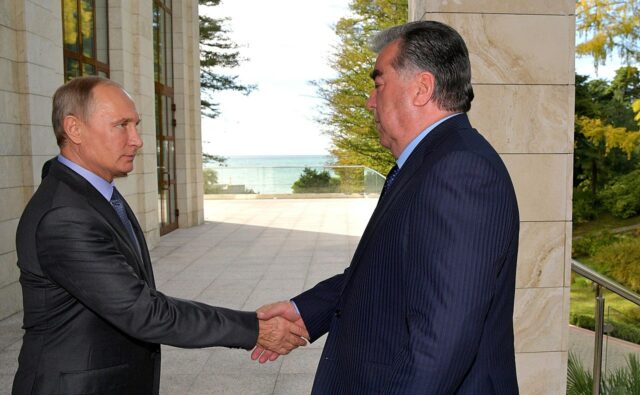Putin-Rahmon’s Meeting: Russia Confirmed Its Hold on Tajikistan

Geopolitical Report ISSN 2785-2598 Volume 35 Issue 4
Author: Giuliano Bifolchi
Emomali Rahmon’s meeting with Vladimir Putin reaffirmed the enduring strategic alliance between Moscow and Dushanbe, underscoring Russia’s deliberate emphasis on fortifying collaborative efforts with Tajikistan, particularly in matters pertaining to defence and security, along with education and societal domains. Concurrently, Dushanbe’s focus remains directed towards garnering essential backing for its domestic and foreign policy initiatives.
Putin-Rahmon’s Meeting in Bishkek: Background Information
On October 13th, 2023, Russian President Vladimir Putin met with Tajik President Emomali Rahmon in Bishkek during the summit of the Commonwealth of Independent States (Izvestiya).
Putin highlighted relations between Moscow and Dushanbe in the security field and the collaboration between the parties organised respecting the strategy Russia and Tajikistan delineated.
In response, Rahmon stressed Russia is Tajikistan’s important strategic ally and remains a leading trading partner. According to Rahmon, cultural ties between Moscow and Dushanbe are expanding.
Earlier, on October 5th, 2023, Putin congratulated Rahmon on his birthday and noted his contribution to strengthening the strategic partnership between the two countries, as well as consolidating mutually beneficial relations within the Collective Security Treaty Organisation (CSTO), the Commonwealth of Independent States (CIS) and the Shanghai Cooperation Organisation (SCO).
On May 22nd, 2023, it was reported that Russian-Tajik trade turnover last year grew by almost 24% and amounted to about $1.7 billion. There is scope for this figure to reach $2 billion in 2023 (Izvestiya).
Tajikistan: A Geopolitical Scenario
Tajikistan has a strategic role in Eurasia because of its adjacency to Afghanistan, the People’s Republic of China, Kyrgyzstan, and Uzbekistan. With about 85 cubic kilometres of fresh water annually, Tajikistan ranks among the world’s foremost custodians of this vital resource.
The country stands at a crossroads of abundant potential and boasts a wealth of natural resources, encompassing mineral reserves, cotton, and a robust hydroelectric capacity. The prosperous agricultural sector, besides the booming tourism industry, bodes well to expand economic diversification.
The demographic landscape, where half the population is under the age of 25, underscores a dynamic and youthful labour force, poised to be a significant driver of growth.
As a participant in Beijing’s ambitious Belt and Road Initiative (BRI), Dushanbe has successfully attracted foreign direct investments (FDIs), pivotal in bolstering the country’s infrastructural backbone.
Concurrently, Tajikistan’s symbiotic relationship with Russia has significantly propelled its economic ascent. The surge in Tajik labourers in Russia, registering a notable 51.8% increase within a year, reflects the intensified demand driven by heightened Russian defence orders and the domestic labour mobilisation.
This surge, coupled with the rouble’s appreciation, has culminated in an upswing in remittances, providing a substantial impetus to household consumption. Furthermore, the influx of Russian refugees, accompanied by their capital, has further amplified economic activity, fortifying the Tajik economic landscape (Coface).
In the realm of Russian foreign policy, Tajikistan has a significant role, intertwined with historical, national security, and territorial integrity concerns for Russia. Indeed, the notion of Russian security extends beyond its national borders, encompassing the entire post-Soviet space.
Given Tajikistan’s proximity to Afghanistan, it emerges as a key player in the security framework of the Eurasian region, as threats emanating from this neighbouring nation have repercussions not only for Russia but also for the broader Central Asia (SpecialEurasia).
Russia’s deliberate focus on Tajikistan’s security role is evidenced by the robust bilateral and multilateral engagements between Moscow and Dushanbe, notably within organisations such as the CSTO, CIS, SCO, and CICA.
Maintaining a preeminent position in the post-Soviet sphere, particularly in Central Asia, remains a vital aim for Russia (SpecialEurasia).
Why does it matter?
Putin-Rahmon’s meeting confirmed the Kremlin’s strategy in Tajikistan and the Central Asia. Indeed, the Central Asian republic is part of Moscow’s blizhnee zarubezhe (near abroad) where the Russian government seeks to expand its influence, confirm its presence, and avoid external influence, especially from the West.
Moscow’s strategy towards Dushanbe follows two prime directives:
- Exploiting security issues and Dushanbe’s necessity to contrast external threats, particularly those coming from neighbouring Afghanistan after the U.S. troops’ withdrawal from Kabul and the Taliban’s rise to power.
- Taking advantage of the Tajik labour migrants in the Russian Federation, whose number increase 207% in 2022 and almost totalled the level of 2013, which has a significant impact on the national Gross Domestic Product (GDP).
Although Dushanbe has attempted to diversify its commercial and diplomatic partners to ease pressure coming from Russia and China, Emomali Rahmon still needs support for the country’s stability considering Western criticism over the national situation of human rights and freedom, especially in the Gorno-Badakhshan Autonomous Region (SpecialEurasia).
The European Union and the United States establish their cooperation with Central Asian republics by emphasising the importance of guaranteeing a democratic process and an amelioration of the local human rights’ condition.
By contrast, the Kremlin allows Dushanbe to conduct its domestic policy without interfering in the domestic dynamics since Moscow seeks local stabilisation to avoid any so-called ‘colour revolution’ which in Georgia, Ukraine, and Armenia have distanced the local governments to Moscow.
In this context, we might expect that Dushanbe-Moscow’s cooperation will increase in security, defence, and society. Therefore, Russia’s grip will become more tangible in Tajikistan, whose consequences might strengthen Emomali Rahmon’s leadership and, simultaneously, create a distance between the Central Asian republic and the West.
Do you like SpecialEurasia reports and analyses? Has our groundbreaking research empowered you or your team? Now is your chance to be a part of our mission! Join us in advancing independent reporting and unlocking the secrets of Eurasia’s complex geopolitical landscape. Whether through a one-time contribution or a monthly/yearly donation, your support will fuel our relentless pursuit of knowledge and understanding. Together, let’s pave the way for a brighter future. DONATE NOW and secure your place in shaping the geopolitical narrative.
